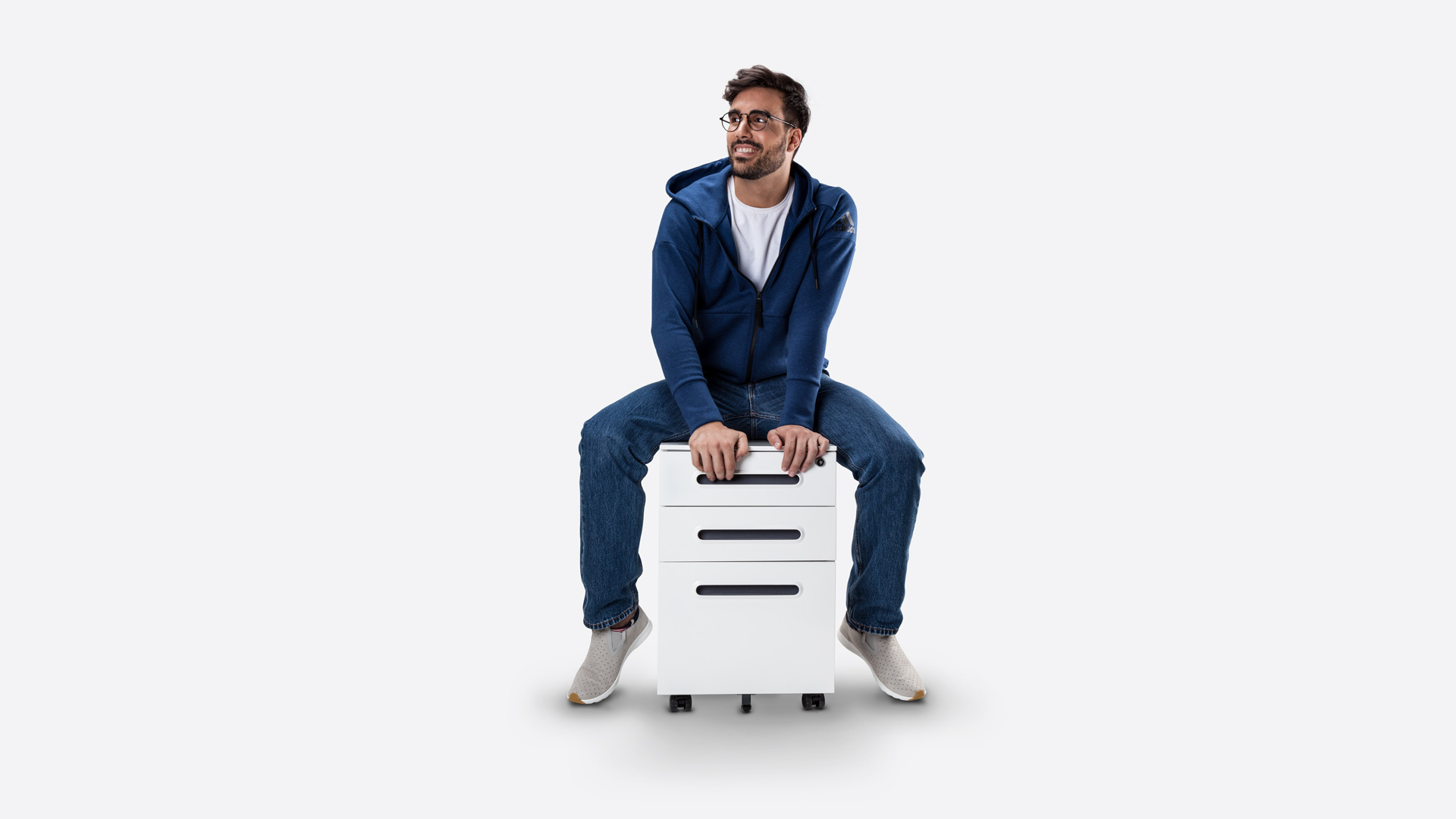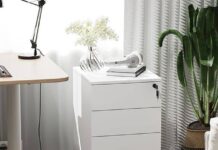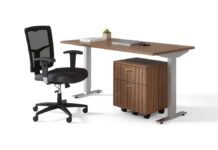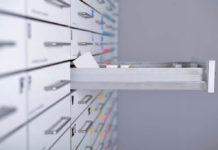In this article, we will discuss a situation where you have lost or misplaced the key of your filing cabinet, and look out for methods to open it.
Will you try to forcefully open your cabinet or call an expert? Here we will discuss all the options you have.
Standingdesktopper's pick
The Scenario
Imagine a scenario, when you wake up one morning looking for an important file stored in your old filing cabinet. You try to open it but it’s locked and you’re unable to find the key. You’re already running out of time for an important meeting and that file is important for you.
Opening up a locked filing cabinet can become a great hurdle if you are running out of time. There are a number of methods that you can still use to open the locked cabinet; however, many of these methods involve techniques that can damage your filing cabinet. Generally, people use techniques such as drilling, prying and hitting the main body of the cabinet. Contrarily, many hire locksmiths to cut a new key for your cabinet or picking the lock for you.
There are many filing cabinets that only use simple wafer locks that can be opened with the help of a paperclip or a safety pin. Though, the concept of picking the lock by a paperclip involves a tiring task of rocking the pin up and down for a number of times to open the lock.
In comparison, this article will inform you of the techniques that you can choose to open your locked cabinet under different circumstances.
Important Considerations
Gaining access to a locked file cabinet requires you to understand the considerations attached to each situation. Intrinsically, each method has its own unique advantage, however, you will have to evaluate your situation and other important factors before using a particular method.
Technically, there are various important considerations while choosing the right method to open a locked filing cabinet such as the construction of cabinet, lock type, and the urgency to open the lock. If you have a plan to dispose-off your old filing cabinet after accessing the required documents, then you can also consider prying the drawer open. As most of the filing cabinets are only made up of thin sheets of metal, prying them is an easy job if you have a pry bar at your helm. However, this will require you to forcefully bend the drawer by using your muscular strength.
Similarly, you also have the option of opening up the locked cabinet by drilling out the lock, if you don’t have a plan to use the filing cabinet again. However, you can also install a new lock cylinder again to your cabinet. The drilling process involves drilling a hole which is slightly larger than the keyhole. The drilling hole must be created by drilling through the pins of the lock. If done properly, then you can easily open the lock with the help of a screwdriver only. Or else, you will need to drill additional holes to cut through the complete lock cylinder in your filing cabinet.
At a professional level, traditional locksmiths use a combination of specific tools and techniques to pick a lock for you. In addition, locksmiths can also cut a new key for your filing cabinet. On the other hand, you can also contact the manufacturing company of the lock to obtain a new key for your lock.
Besides, many filing cabinets use wafer locks that can be easily picked by yourself only. The main principle behind picking these locks is to push the wafers in the upward direction. Generally, lockpickers prefer to insert a key into the lock hole and manually rock the wafers. You can also use a safety pin or a metal piece to push the wafers. However, if your locking system is complex then you will have to purchase a new lockpicking kit to open it.
Conventional Methods to Open a Locked Filing Cabinet
In the previous section, we discussed the different considerations and factors that need to be addressed before trying to open a locked filing cabinet. In this section, we will discuss in detail all the available options you have at your helm to open your locked cabinet.
-
- Tilting and Poking your Cabinet: This step involves manually tilting and poking with a rod to disengage the cabinet’s locking system. However, the ability to open a lock with tilting and poking depends on the type of filing cabinet you have. To perform this maneuver, you have to ask the help of a friend or person to tilt the front face of the cabinet in the upward direction. Further, you will have to manually probe with a metal rod inside the filing cabinet for a hole. In this hole, there will be a particular edge that needs to be pushed to unlock the cabinet.
- Using a Matching Key: This step involves using the spare key to open the locked filing cabinet. Generally, in offices, there are spare keys stored inside separate lockers in case the original key is lost or misplaced. Hence, you can look around your office or ask the staff for the spare key.
- Contacting the Manufacturer: This method can be used in cases if you don’t need a particular file stored in the locked filing cabinet, immediately. If you have ample time, you can easily contact the manufacturer and request for a spare key. Generally, every lock and key have a specific number which can be used to issue a new key for the same lock system. Hence, you can call the manufacturer and provide the unique key number and get a new key issued for your locked filing cabinet.
- Picking the Lock: This strategy involves using your own hands to pick the lock and unlock the cabinet. To carry out this methodology, you will need a paperclip and a bobby pin. First, you will have to straighten the paper clip. Then, you will have to use the L-shaped bobby pin and insert it in the keyhole. Afterward, you have to insert the modified paperclip through the lock’s top and feel the pins of the lock while you wiggle the clip. Once, you manage to create tension with the bobby pin and apply pressure with the paperclip on the pins in the lock, you can turn the pin and unlock the cabinet. Conventionally, this method requires a lot of practice and skill. Hence, it is difficult for an average person.
- Drilling the Lock: This step involves the risk of doing permanent damage to your filing cabinet. This step must only be performed when you have a plan to not to use the cabinet afterward. To drill through the locking mechanism of the filing cabinet, you will have to use a metal drill in a straight line perpendicular to the lock. Furthermore, you will have to continue to drill your way through until the lock falls inside the cabinet, and you are able to open the cabinet.
- Using an Impact Screwdriver: Before beginning this step, you will have to make sure to use an impact screwdriver only as any ordinary screwdriver can break or bend during the maneuver, and harm your hands. Similar to the drilling maneuver, this method also inflicts permanent damage to the filing cabinet and must only be used when all other methods of opening the locked filing cabinet have been exhausted. To begin, you have to align the screwdriver perpendicular to the keyhole and strike it with a hammer. Once you begin knocking down the screwdriver into the keyhole, make a large hole while turning the screwdriver to break the locking system.
- Using a Kitchen Knife: This is also a step that involves a risk of physical harm to your hands. As kitchen knives are sharp and precise, you can accidentally land up a nasty cut on your hands. Hence, you will have to progress with caution. Generally, lockpickers use a flat and thin knife that can be inserted into the keyhole. Once the knife is in the keyhole, you can point it towards the lock and turn it slowly to open the lock.
- Using a Bump Key: To get a bump key, you have to visit your nearest hardware store and purchase it for a couple of bucks. Traditionally, bump keys can be inserted into any lock. Hence, using a bump key to open a filing cabinet can be a useful alternative if you’re unable to find a locksmith anytime soon. While purchasing a new bump key, make sure that the purchased key fits inside the lock of your filing cabinet. Once, it is inserted into the lock, you will have to tilt it a bit and then bump it in. Doing this maneuver involves some degree of a learning curve, so it will take some amount of time before you can master its usage.
- Hiring a Professional: If you have lost your key and want only an expert to handle your filing cabinet, then you can hire a professional locksmith to open the cabinet for you. Many companies provide locksmith services to the users in an easy and convenient way. Locksmiths have a special set of tools with which they can open any cabinet in a minimum amount of time without damaging the structure or body of the filing cabinet. However, a locksmith will charge some amount of fees from you in exchange for his services.
4 Tips from Locksmiths to Remember
It is important to understand the tips and advice given by the experts. Inherently, professional locksmiths have a similar approach to open any locked cabinet. While every locksmith may have a different technique and set of tools to open a lock, there are still some common attributes found in every locksmith professional. These are:
- Not to panic in any situation: The primary requirement of every individual who is looking to open a locked cabinet is to remain calm and composed in any situation. Many times, you are in a hurry and require some documents urgently which are locked inside a filing cabinet. It is important for you to evaluate your options to open the lock and choosing the best possible method to open it.
- Choose extreme methods only if it is urgent: Many times, people choose to break open a safe or cabinet when other options are also available. It is important for the individual to use extreme steps only in the situation when other options to open a cabinet are not available.
- Hire professionals only from an authentic service provider: While hiring a professional locksmith to open a lock for you, it is important to use authentic service providers only. Many times, locksmith service providers charge hefty amounts from their customers. Hence, it is important to evaluate the rates of every company before hiring them. Apart from that, fraudulent locksmiths will intentionally use difficult maneuvers such as drilling and hammering to open the lock, in order to charge more from you.
Conclusion
In this article, different techniques and methodologies to open a locked filing cabinet are provided. Many times, we misplace or lose the original key and end up losing access to important files and documents. To counter such situations, it is important to remain calm and evaluate all the available options to open the lock. In this article, various techniques such as lockpicking by paperclip, drilling, using bump key, using a kitchen knife, etc. are provided. However, selection of the specific methodology involves a careful evaluation of the available alternatives. If the person is able to open the lock without breaking apart the entire cabinet, then there is no need to use brute-force or methods that can permanently damage the structure of the cabinet.
In addition, we must also make sure that the hired locksmith professionals are authentic and only charge a reasonable price for their services.
- People also read: Filing Cabinet Dimensions






![[Review] Top 5 Best Fireproof File Cabinets in 2024 [Review] Top 5 Best Fireproof File Cabinets in 2020](https://standingdesktopper.com/wp-content/uploads/2020/07/best-file-cabinets-218x150.jpg)



